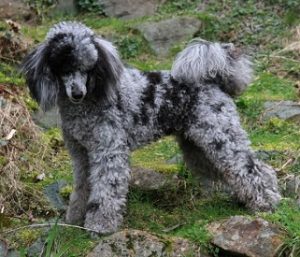You have seen intelligent, classy, and charming poodles in many colors. If the term “merle” surprises you, know that it’s a dog that has light and dark patches on its entire coat. However, being merle is more than just a coat color. So merle poodles are dogs who look like merle but have an entire symphony of hues spread all over the coat.

What is being merle?
Being Merle is more linked with the dog genes. We know how DNA is encoded in the genes that are responsible for the whole existence to the minutest details. Merle dogs have a genetic pattern in their DNA that creates mono-color coat patterns as if the color is spread all over the body. Usually, this pattern is like dark patches on a base of a lighter shade of the same color.
To understand this let’s talk in easy terms and don’t divulge in the language of science. So Basically merle is a genetic alteration that usually results in color pigmentation throughout the body. It can affect dog coats, noses, and eyes.
Fact: merle is actually “discoloration”.
What is a merle poodle?
A merle poodle is a poodle dog that has a merle coat. People have seen, bred and loved poodles for centuries. This may be hard to accept but Yes! Merle poodle exists!
In poodles usually, merle happens in grey and black. As poodles are black so the greyish blue patches are formed all over the coat. Merles are rare and beautiful. Also, a merle poodle will have light blue eyes and maybe a pinkish nose to tell the whole merle tale.
Cryptic merles
Merle genes in poodles are not always prominent. As merle has a link with genes so a poodle can be merle deep down in DNA but may not show patterns at all. Such a trait is called “phantom merle” or “cryptic merle”. These dogs with hidden merle genes can still be a carrier to genes. So breeders need to breed these dogs carefully.
Is merle natural in poodles?
Merle poodle is rare. The symphony of colors in each dog is unique and the patterns are beautiful. However, people claim that merle poodles are not natural. Why? Because Merle doesn’t happen in poodles. It was introduced by some other breed to poodles. This claim makes merle poodle a mixed breed but genetic testings have shown that purebred poodles can also have merles.
Theories claim that even if purebred merle poodles are traced back to generations, one will surely find a foreign merle dog introduced in the breed. Some other theories suggest that because merle gene can stay hidden in white or cream-colored dogs. So it was hidden in poodles too which makes it naturally occurring.
Well, poodles were bred with many colored dogs and if merle was hidden, it must show out in early breeding history. Which it didn’t. This is the dominant gene and poodles don’t have this genetic sequence in their DNA unless it was introduced.

Can a merle poodle be crossed with another merle poodle?
Well, breeders are strict about this. No two merles dogs should be crossed together. A merle dog happens when a responsible pair of genes undergo a certain mutation. When two merle dogs are crossed together, the trait is carried in the next generation. Here recall that this is actually “discoloration ” of pigments which means it’s a gene defect somehow.
Dogs with two merle parents will have a dominant merle gene which can cause vision and hearing loss in dogs. Two merle parents will give birth to a litter with half merle, quarter non-merle, and quarter double merle puppies. Double merles will be discolored dogs with white bodies and pink noses (which is due to lack of color pigment).
If you breed a merle poodle with a non-merle poodle, you will get a half litter of merle poodles and half puppies will be non-merle. The good news is, all dogs will be fine. A problem arises when a phantom merle who is not discovered is crossed with a merle poodle. Two Merle dogs surely produce double merle genes that can lead to serious health issues.
Is every merle poodle a “defected ” dog?
Well, No. Merle poodles can be as healthy as any other poodle. They will have same traits, the same size, and even the same life expectancy. So what’s the difference here?
First of all, they are not purebred poodles. They look like poodles but the merle gene makes them “mixed breed”. Merle gene is a semi-dominant gene which means it will require a dominant carrier to carry it in coming generations. So poodles were never “merle” naturally. They were made this way through merle’s introduction.
Secondly, the dogs with one merle gene are fine. These dogs have one merle and one non-merle parent. Whereas double merle dogs with both merle parents will have double mutated genes and that is responsible for birth defects in dogs.
Merle poodles must be carefully bred. It’s important to know their genetic history before crossing them with other dogs. Genetic testing is done to see if a poodle is a merle or not. This is also important to see if any phantom merle exists in the crossing pair.

Merle poodle health issues?
As we have clearly stated that merle dogs can be as healthy as other dogs. The problem arises when two merle poodles are crossed. This ensures that some of the puppies will have double genetic mutations and will be born with genetic defects. The merle poodles can have birth defects like
- Deafness
- Blindness
- Microphthalmia (a rare defect of having small eyeballs that may need to be removed later on)
- Skin cancer because of less color pigmentation.
Double merle dogs are never born “healthy “. They may die at a very early age or fall ill in the early years of their life.
As these dogs have hearing and vision problems, they clearly can’t catch up with a quality life that other siblings may enjoy. It’s difficult to train dogs with less hearing or vision and also these dogs are less socialized than others.
How to spot a merle poodle?
Well, there are certain breed standards for poodles and not having blue eyes is one. If a poodle has blue eyes, he has the merle gene. Similarly, a pink nose is also a sign that a poodle is a merle. Double merle poodles can have more than one trait that clearly shows they are merle. Like patches on white bodies, pink nose, pink paw pads, and blue eyes. Usually, the merle gene is hidden in White and cream-colored dogs.
Why merle poodles are not AKC recognized?
Poodles are purebred. Then why AKC doesn’t recognize merle poodles when it recognizes some other dogs who have merle genes.
This is because merle is not a natural phenomenon in poodles. This is surely a result of cross-breeding somewhere in the line. So AKC disqualifies poodles with doodles. Ouch! It hurts. They are such a delight to our sore eyes.
While AKC doesn’t recognize merle poodles it certainly doesn’t mean that it doesn’t register a merle poodle as well. If a merle poodle has two purebred parents who are AKC recognized, AKC will register the merle poodle. You can register them under the “multi-color ” category because merle is not defined as any color in AKC standards.

Merle poodle colors
Merle mostly happens in black color. But as poodles have different colors, merle can emerge in any color too. Blue merle poodles are common. Usually, these are grey poodles whose black patches appear as blue shades. Similarly, red merle poodles are poodles with rusty tints all over. Chocolate merle poodles are poodles with brown markings.
Merle Poodle Temperament
Mostly, merle poodles have a calm aura and affectionate personality but it has nothing to do with being merle. Poodles are anyway very family-loving dogs and are known for their intelligence, obedience, and loving nature.
How parti poodles are different from merle poodles?
Merle poodles have a unicolor pattern with variant shades of the same color. Whereas Parti poodles have two distinct colors in their coat. Parti poodle usually has a white base with another different color as patches like white and brown, red and white or black and white, etc. Merle poodle on the other hand usually has a greyish base coat and the patches appear in grey, blue or black color.
Does the merle coat fade away?
Hell no!. This is genetics and not some grooming and coloring session where the color will fade away after few washes. The merle poodle will stay merle for whole life.
Can merle happen in any poodle?
Poodles have three types of breeds. Standard poodle, mini poodle, and toy poodle. The height of a standard poodle is more than 15 inches, toy poodles are up to 10 inches and mini poodles are below 15 inches. If bred purposefully, Merle can happen in any breed.
How much does a Merle poodle cost?
Merle poodles are not common and so are berry costly. All the rare things come with their price and a merle poodle price can be up to $5000. Quite a cost…
Merles of all puppies are different. Some patterns are very beautiful and catchy. This can cause a significant increase in merle poodle price.

Merle Poodle Breeding
As long as breeders are taking precautions, there is no harm in adding beauty to a puppy. Whereas people clearly disagree to create merle poodle. Introducing non-occurring genes in generations is risky for dogs’ health. It doesn’t only affect their purebred status, it also comes with severe health issues.
So merles may be beautiful, rare, or anything attractive but they are a threat to health. It’s a matter of their well-being.
In short, merle poodles are beautiful but while breeding them purposefully, breeders must be very careful.

